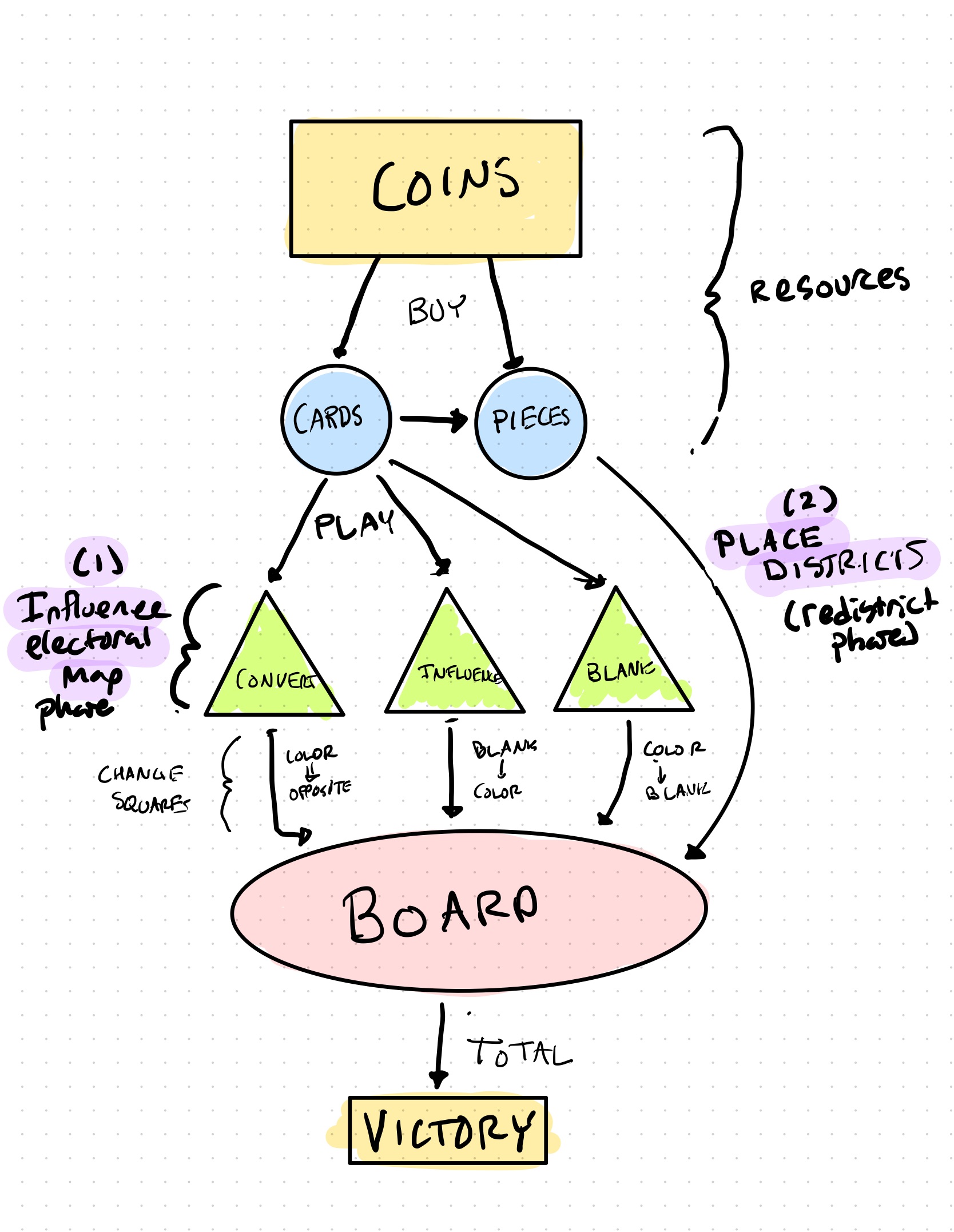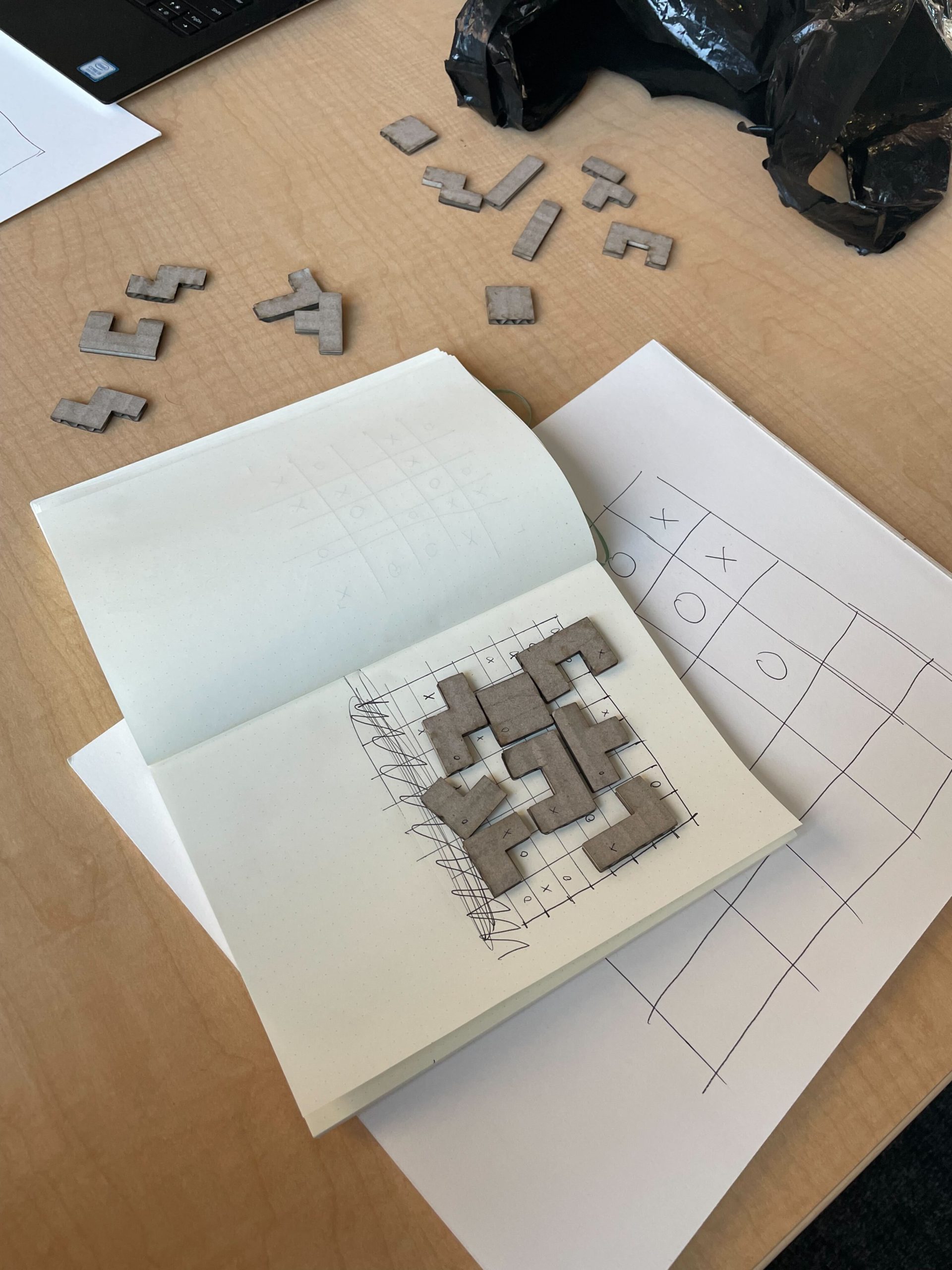Posted for David, Eugene and Goutham.
Faction: Gerrymander Like Your Favorite Politicians!
Artist’s Statement:
Factions is a two-player game designed to put the player in the position of a political party, competing with an opposing party to win an election through gerrymandering a state. As players compete through placing tetris-style pieces on a limited 8×8 board, they realize that they must play “dirty” by using gerrymandering strategies like packing and cracking to win. By playing this game, players are introduced to the sort of data-driven, zero-sum decision making that is involved in creating districts to win elections.
Ecosystem:
Factions is intended to model the political party system, particularly when it comes to creating state voting maps and gerrymandering. Players act as political parties, interacting with a state map represented by an 8×8 grid populated with randomized voters. By influencing the board to change through spending political capital, players emulate the decisions made during the 10 year cycle between censuses. In addition, players take turns placing complex district maps to make a winning strategy for their party.
Learning Outcomes & Approach:
By playing this game, players get a look into the strategies used in gerrymandering such as cracking and packing. Cracking is when a party dilutes the voting power of another party by spreading their votes across many districts. Packing is when a party concentrates the votes of an opposing party into a single district. Furthermore, players should learn the “dirtiness” of gerrymandering and feel that the system is broken and rewards vote manipulation. Players have to employ these strategies and this abuse of the system in their role as the political party in the game.
System Models

Our model of the actual system of elections and gerrymandering

Concept map of our board game.
Initial decisions
We tried to have our formal elements map the real-world – two-party, corrupt – system of gerrymandering.
Formal elements: In service of this, we made it a 1v1 competitive game. In terms of types of fun, we targeted challenge and narrative. We wanted the two players to compete, and be able to tell a story afterwards that was evocative of the experience of gerrymandering. Our core mechanic was area control: drawing out the districts with tetris pieces. Given a board marked with the two players colors, they had to take turns placing pieces that were majority their color to gain districts. Whoever had the most districts at the end one. We wanted to express the zero-sum nature of gerrymandering, and how votes could be suppressed through the process.
Values: We wanted people to have an awareness of the real-world system of gerrymandering happening in their own districts, and the knowledge that it’s deeply unfair. We hoped to encourage people to advocate to change it.
Testing and iteration history

The first playtest of the tile placement mechanic.
Version 0
For our first version, we knew that we wanted some type of area control mechanic to model drawing the lines between districts. Although our initial concept was physically placing lines, we quickly switched to tetris pieces. The basic gameplay at this point was:
- A board which is a grid of squares, which are either blank or have marks (representing constituencies) for player 1 or player 2
- A shared pool of tetris pieces
- Players take turns placing tetris pieces onto the board: if the piece covers more of their marks then they win the district
- Gameplay continues until there are no valid spots to place. Whomever has more winning districts wins the game.
This very basic version was compelling, and convinced us that we were on to something. However, we wanted to model not just the districting, but the process of converting localities to your side as well.

Cynthia and Rachel testing version 1 of the game.
Version 1
In version 1, we expanded the board, and added an initial phase were you could buy cards or pieces, and influence the map. This first phase was meant to simulate the political influencing that goes on in between redistricting attempts.
- Added cards, with three basic verbs: convert, influence and blank, which could change the allegiance of a square
- Added costs to the cards and pieces, and a pool of 10 coins to spend to acquire them
- Expanded the board, and added more markers on the squares
The second portion of the game was fairly successful, but playtesters said that the first part felt random and not very impactful.
NOTE: There’s also a YouTube video of this playtest, and the discussion afterwards, which will be attached to this post as a comment. See below!
Version 2
In version 2, we added theming to the cards – giving them names relevant to the actual actions – and significantly increased their impact (i.e., you could convert many more squares).
- New set of cards
- More impactful actions attached to the cards
The feedback from this playtest echoed a sentiment we’d heard in the first: the game felt either too random, or like it required too much thinking. People who loved games like Chess wanted it more deterministic and structured, others wanted it lighter. However, throughout all the playtests we did get solid feedback on the second, piece placing phase, and saw practices like packing and cracking, which happen in real gerrymandering, emergently appear, which validated that we were capturing at least some of the systems. When the actions are more impactful as well, they were torn between using the actions or buying the tiles. However, more can be done to tie the cards and the tiles, and would be addressed in the newer iterations.
Possible Next steps:
- Tying actions closely to the tiles
- More variety of tiles
- Reduction of cost
- Bigger size
- Reference cards
- Rebranding the titles (action cards -> political capital cards)
Cards (Political Capital)
There are only 12 cards. The cost are circled in red, while the associated district pieces are in green.
Tetris Pieces (Districts)
You can print these tetris pieces and play them
Game Board (Faction)
This is a sample of the game board. There are 8×8 tiles and 24 voters in each political party in the game board
Rules
Appendix:
- District – A district consist of one tetris piece. To win the district, there should be more of your own color than your opponents. Blank tiles do not count to any political parties.
- Faction – Faction is the game board. Your goal is to win more districts than your opponent in this faction.
- Political Capital – Political Capital are cards that you can used against your opponents. You have to use your Political Capital cards immediately upon purchase.
Setting up:
Each player should have 10 million dollars each to begin the game. Set the Districts aside, and shuffle the Political Capital cards. Open 3 Political Capital Cards and set them open on the table.
Starting the game:
Preparation Phase:
The older person will start the game. A player will do either actions
- Buy 2 districts with 1 million dollar.
- Buy either of the 3 opened Political Capital cards with the cost designated above. Act on the description written on the card immediately upon purchased.
Players will take turns doing these actions.
The Preparation phase will last until the last player finish their money. If one player has finished using their money while the other has not, the player with remaining money will spend their money continuously until it is depleted. Once this is done, we will begin the Gerrymander phase.
Gerrymander Phase:
Once all players finished their money, they will then proceed to this phase. The player with more district pieces will start their turn. The player will put their district on the faction.
To win the district, there should be more voters voting for you than your opponent. Blank tiles does not count towards any political party. For example, if the district has 5 tiles, and 2 tiles are blank tiles, 2 tiles are yours and 1 tile is your opponent, you will win the district if you place a district there. You can place a district that your opponent wins as well, if that is a more strategic move for you. You can also place a district if there are equal number of voters. However, neither player will win that district.
The players do not have to place a district if they do not want to. In that case, the player will pass their turn, and the next person will place their district. The game ends when both players do not want to put any district, or could not put any more district in the faction.
Once the game ends, the players will start counting the number of district they have. The player with the most district in the faction will win the game. If there is a tie, the player who spent the least on political capital will win the game. If there is a tie again, a rematch is needed to determine the ultimate winner.




Playtest video: https://youtu.be/F_q2Hv31b3I